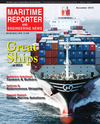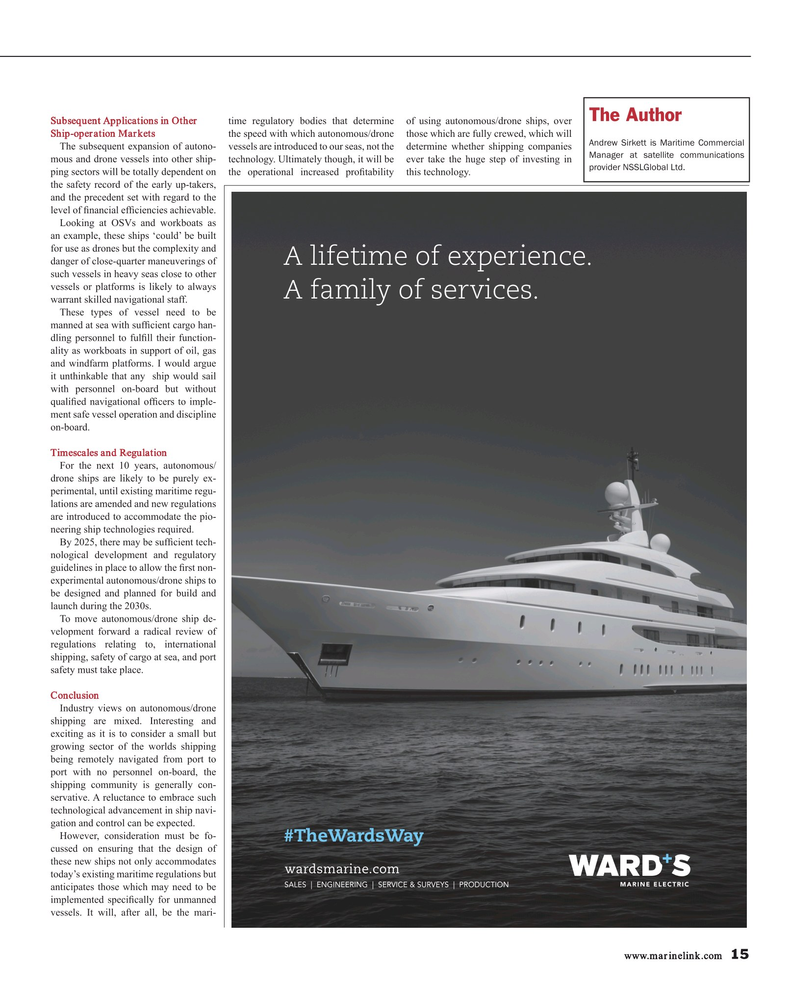
Page 15: of Maritime Reporter Magazine (December 2015)
Great Ships of 2015
Read this page in Pdf, Flash or Html5 edition of December 2015 Maritime Reporter Magazine
The Author
Subsequent Applications in Other time regulatory bodies that determine of using autonomous/drone ships, over
Ship-operation Markets the speed with which autonomous/drone those which are fully crewed, which will
Andrew Sirkett is Maritime Commercial
The subsequent expansion of autono- vessels are introduced to our seas, not the determine whether shipping companies
Manager at satellite communications mous and drone vessels into other ship- technology. Ultimately though, it will be ever take the huge step of investing in provider NSSLGlobal Ltd. ping sectors will be totally dependent on the operational increased pro? tability this technology. the safety record of the early up-takers, and the precedent set with regard to the level of ? nancial ef? ciencies achievable.
Looking at OSVs and workboats as an example, these ships ‘could’ be built for use as drones but the complexity and danger of close-quarter maneuverings of such vessels in heavy seas close to other vessels or platforms is likely to always warrant skilled navigational staff.
These types of vessel need to be manned at sea with suf? cient cargo han- dling personnel to ful? ll their function- ality as workboats in support of oil, gas and windfarm platforms. I would argue it unthinkable that any ship would sail with personnel on-board but without quali? ed navigational of? cers to imple- ment safe vessel operation and discipline on-board.
Timescales and Regulation
For the next 10 years, autonomous/ drone ships are likely to be purely ex- perimental, until existing maritime regu- lations are amended and new regulations are introduced to accommodate the pio- neering ship technologies required.
By 2025, there may be suf? cient tech- nological development and regulatory guidelines in place to allow the ? rst non- experimental autonomous/drone ships to be designed and planned for build and launch during the 2030s.
To move autonomous/drone ship de- velopment forward a radical review of regulations relating to, international shipping, safety of cargo at sea, and port safety must take place.
Conclusion
Industry views on autonomous/drone shipping are mixed. Interesting and exciting as it is to consider a small but growing sector of the worlds shipping being remotely navigated from port to port with no personnel on-board, the shipping community is generally con- servative. A reluctance to embrace such technological advancement in ship navi- gation and control can be expected.
However, consideration must be fo- #TheWardsWay cussed on ensuring that the design of these new ships not only accommodates wardsmarine.com today’s existing maritime regulations but
SALES | ENGINEERING | SERVICE & SURVEYS | PRODUCTION anticipates those which may need to be implemented speci? cally for unmanned vessels. It will, after all, be the mari- www.marinelink.com 15
MR #12 (10-17).indd 15 12/4/2015 11:28:18 AM

 14
14

 16
16
